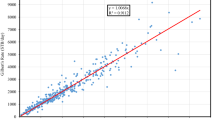Abstract
A numerical experiment has been carried out to study the influence of the change in the main pipeline cross-section due to hydrate formation on hydraulic resistance and the temperature and pressure dynamics taking into account quasi-stationary heat transfer with permafrost ground. The case where a wet gas is supplied to the pipeline is considered, and the dynamics of hydrate formation is determined along with other parameters. The calculations are carried out until the outlet pressure becomes lower than the standard one. The results of the experiment show that a model assuming a constant hydraulic resistance coefficient leads to a significant underestimation of the allowable pipeline operation time. Consequently, in mathematical modeling of hydrate formation in natural gas pipelines taking into account the relationship between heat transfer and viscous friction is critical.
Similar content being viewed by others
References
E. A. Bondarev, I. I. Rozhin, A. F. Voevodin, and K. K. Argunova, “Thermohydrodynamics of the Power of Siberia Gas Pipeline,” in Problems of Optimization of Complex Systems, Proc. 12th Int. Asian Workshop, Novosibirsk, December 12–16, 2016 (Inst. Mat. Mat. Geofiz., Sib. Branch, Russian Acad. of Sci., Novosibirsk, 2016), pp. 79–86.
E. A. Bondarev, I. I. Rozhin, and K. K. Argunova, “Features of Mathematical Modeling of Natural Gas Production and Transport Systems in the Russia’s Arctic Zone,” Zap. Gorn. Inst. 228, 705–716 (2017) [J. Mining Inst. 228, 705–716 (2017)].
E. A. Bondarev, V. I. Vasil’ev, A. F. Voevodin, N. N. Pavlov, A. P. Shadrina, and E. A. Bondarev, Thermohydrodynamics of Gas Production and Transportation Systems (Nauka, Novosibirsk, 1988) [in Russian].
E. A. Bondarev and A. F. Voevodin, Solving Problems of Pipe Hydraulics in Natural Gas Production and Transportation Systems (Izd. Sib. Otd. Ross. Akad. Nauk, Novosibirsk, 2017) [in Russian].
K. K. Argunova, E. A. Bondarev, V. E. Nikolaev, and I. I. Rozhin, “Determination of the Interval of Hydrate Formation in Wells Drilled in Permafrost Rocks,” Neftegaz. Delo (2008); http://www.ogbus.ru/authors/Argunova/Argunova2.pdf.
K. K. Argunova, E. A. Bondarev, and I. I. Rozhin, “Mathematical Models of Hydrate Formation in Gas Wells,” Kriosf. Zemli 15 (2), 65–69 (2011) [Earth’s Cryosphere 15 (2), 65–69 (2011)].
E. A. Bondarev, I. I. Rozhin, and K. K. Argunova, “Modeling the Formation of Hydrates in Gas Wells in Their Thermal Interaction with Rocks,” Inzh.-Fiz. Zh. 87 (4), 871–878 (2014) [J. Eng. Phys. Thermophys. 87 (4), 900–907 (2014).
E. A. Bondarev, I. I. Rozhin, and K. K. Argunova, “A New Algorithm of Mass Flow Rate Determination in Gas Production and Transport Systems via Pressure Measurement,” Prikl. Mekh. Tekh. Fiz. 58 (5), 111–120 (2017) [J. Appl. Mech. Tech. Phys. 58 (5), 853–861 (2017).
E. A. Bondarev, I. I. Rozhin, K. K. Argunova, and A. F. Voevodin, “Thermohydrodynamics of Gas Pipelines in the Cryolithozone,” in Transportation and Storage of Petroleum Products and Hydrocarbons, No. 4, 18–22 (2017).
M. P. Vukalovich and I. I. Novikov, Equations of State for Real Gases (Gosenergoizdat, Moscow–Leningrad, 1948) [in Russian].
W. B. Kay, “Density of Hydrocarbon Gases and Vapors at High Temperature and Pressures,” Industr. Eng. Chem. Res. 28, 1014–1019 (1936).
E. D. Sloan and C. A. Koh, Clathrate Hydrates of Natural Gases (Taylor and Francis Group–CRC Press, Boca Raton, 2008).
STO Gazprom 2-3.5-051-2006: Standards of Technological Design of Gas Pipelines, Introduced July 03, 2006 (Poligrafia, Moscow, 2006) [in Russian]
Author information
Authors and Affiliations
Corresponding author
Additional information
Original Russian Text © E.A. Bondarev, I.I. Rozhin, K.K. Argunova.
Translated from Prikladnaya Mekhanika i Tekhnicheskaya Fizika, Vol. 60, No. 3, pp. 120–127, May–June, 2019.
Rights and permissions
About this article
Cite this article
Bondarev, E.A., Rozhin, I.I. & Argunova, K.K. Generalized Mathematical Model of Hydrate Formation in Gas Pipelines. J Appl Mech Tech Phy 60, 503–509 (2019). https://doi.org/10.1134/S002189441903012X
Received:
Revised:
Accepted:
Published:
Issue Date:
DOI: https://doi.org/10.1134/S002189441903012X




